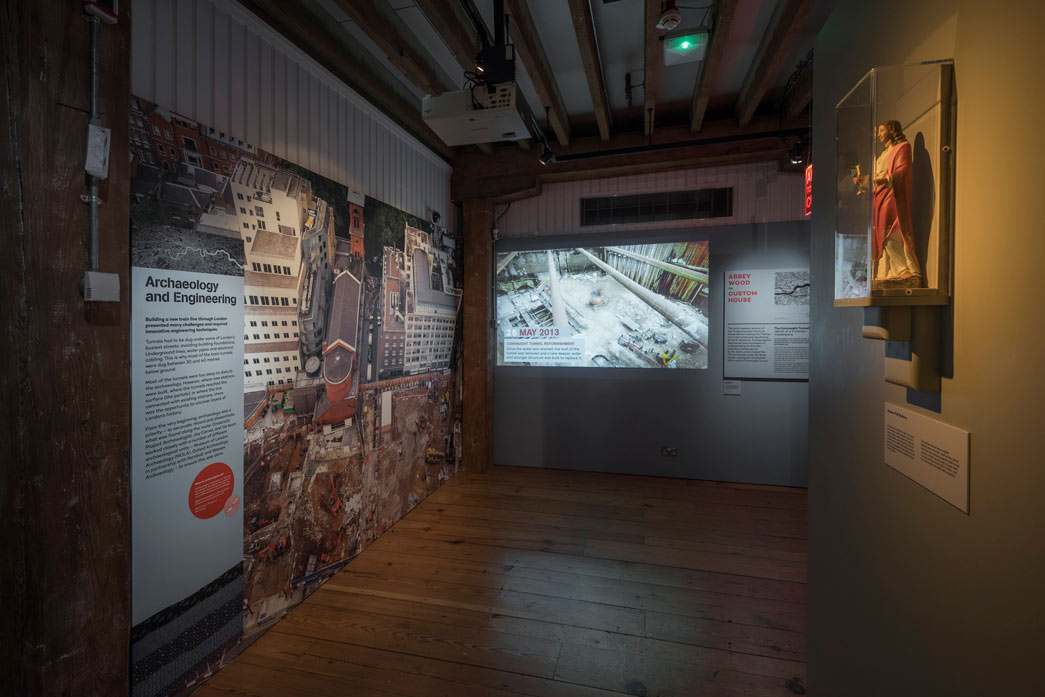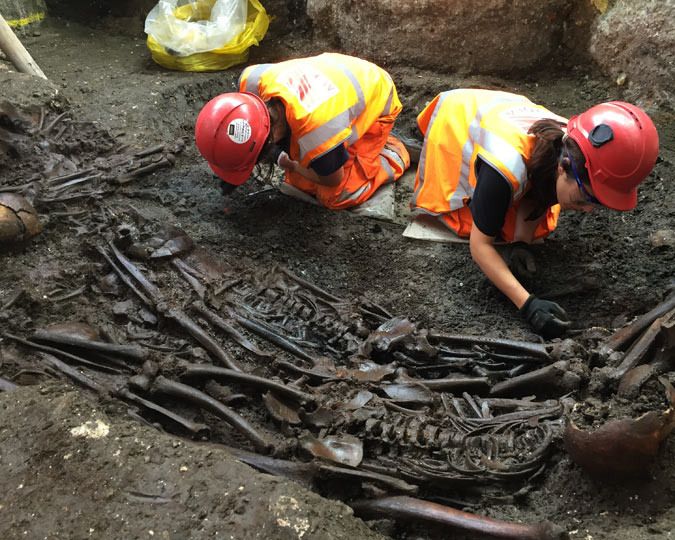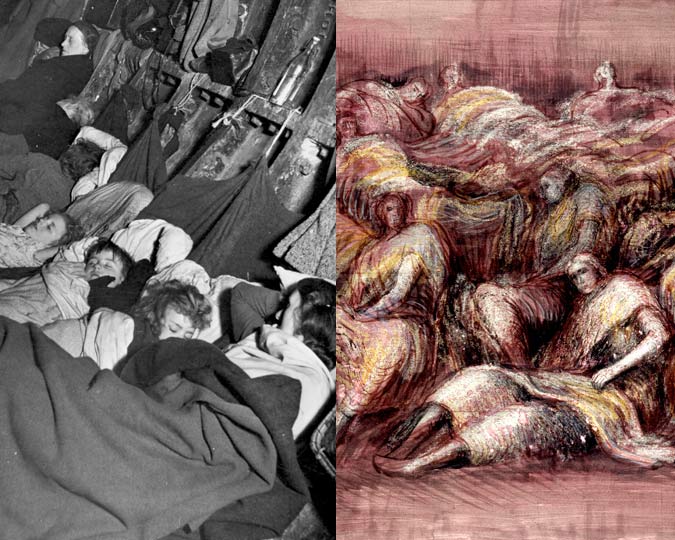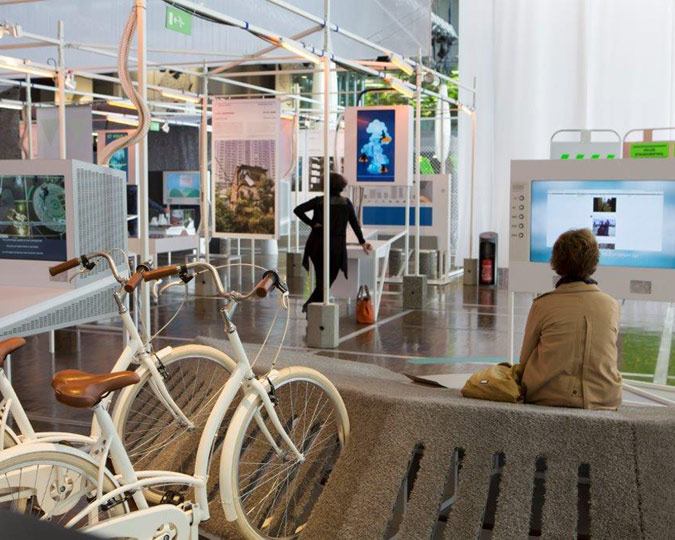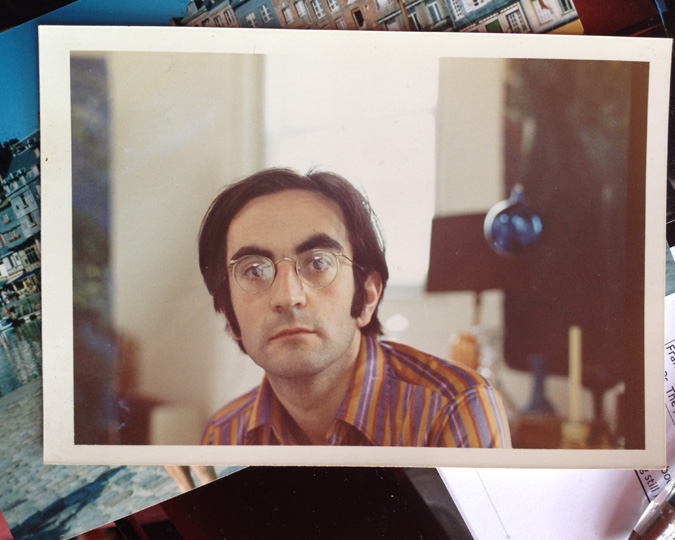What does a medieval saint have to do with the modern Crossrail tunnel beneath London?
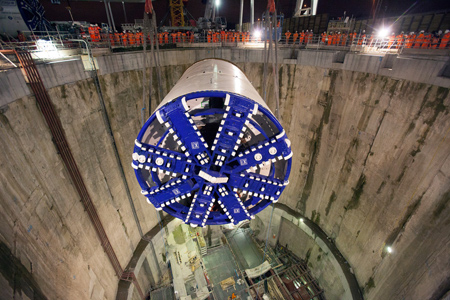
Tunnel boring machine Elizabeth is lowered into the main shaft
October 2012. © Crossrail, photographer John Zammit.
When thinking about the Crossrail project, most people probably think about the trains, or the enormous tunnel boring machines (TBM’s), or about the tunnels themselves, running deep beneath London. But perhaps a less well-known fact is that that an early Christian saint also played a role in this huge construction project. A small plaster statue of Saint Barbara was to be found in the tunnels during construction and one of these statues featured in the 2017 Tunnel: The Archaeology of Crossrail exhibition at the Museum of London Docklands. But who was Saint Barbara and why did she play a role in the building of the Elizabeth line?
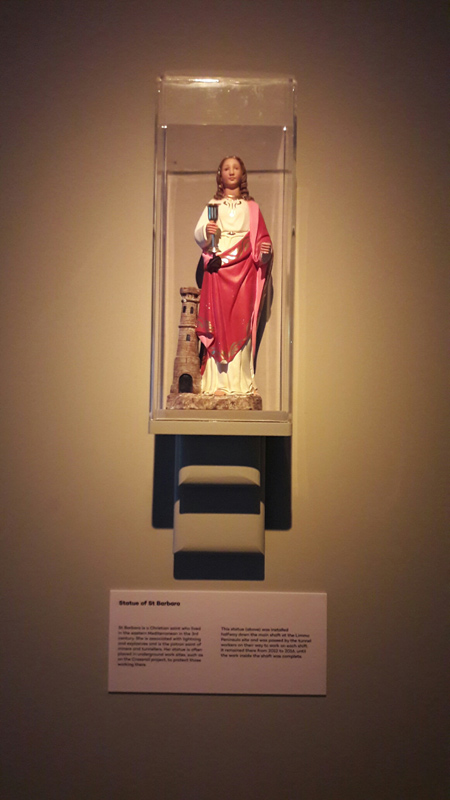
Statue of Saint Barbara
On display in the Tunnel: The Archaeology of Crossrail exhibition at the Museum of London Docklands.
Barbara is believed to have lived in the 3rd century AD in the eastern Mediterranean, probably in modern Turkey or Lebanon. She was the beautiful daughter of a wealthy man and, while he was away, to ensure she remained virtuous, he had her locked in a tower. She secretly converted to Christianity and when her father had a bathhouse built for her, she asked the builders to place three windows in it to symbolise the Holy Trinity of the Christian church. When her father saw the windows he recognised their significance and became enraged, reporting her to the authorities. She was arrested, tortured and eventually sentenced to death by beheading. Her father himself carried out the sentence with his sword. He was then struck by lightning and killed, and his body consumed by flames, said to be divine retribution for the murder of his daughter. Because of this, Barbara became associated with thunder, lightning and sudden death.
She is first mentioned as a saint in the 7th century, but became increasingly well-known from the 9th century on. In the 14th century she was recognised as one of the Fourteen Holy Helpers, a group of saints who became particularly venerated due to the belief that they could protect against disease and sudden death. Their veneration began in the Rhineland in Germany at a time when the area was suffering from the Black Death and spread quickly throughout Europe. Barbara is often to be found depicted in medieval works of art, such as church paintings and statues.
Her association with sudden death and lightning soon found a
new outlet. Chemical explosive – gunpowder or black powder – were developed by
the Chinese, largely for use in fireworks. Knowledge of it spread in the
medieval period to Europe where its potential for warfare was recognised and
developed. Barbara soon became associated with explosives and she became the
patron saint for those who worked with them, such as artillery-men, military
engineers and miners.
She was, therefore, an important saint in the medieval church and features in the small portable souvenirs and badges that were bought and worn by pilgrims in medieval Europe. The collections here at the Museum of London feature a number of images of St Barbara. Some may have come from shrines in continental Europe, but others may have been associated with the relic of St Barbara’s head which was located at Halesowen Abbey in the Black Country. This is one of a number of sites that claimed to have relics of the saint’s head. A description of 1505 describes the relic at Halesowen as encased in silver and gilt. After the Dissolution, it was taken to Worcester but after that disappeared.
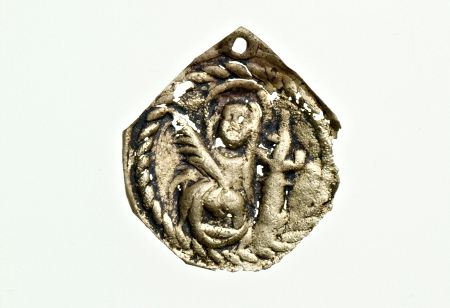
Devotional badge of Saint Barbara
Medieval pilgrim souvenir, 15th century. Thin copper alloy badges like this one were sewn onto clothing or into the pages of prayer books.
On display in the medieval London Gallery is a small copper-alloy disc. It depicts St Barbara on one side holding the sword with which she was beheaded and the palm which symbolises her martyrdom. The reverse shows a letter ‘B’. The disc has been perforated and may have been sewn onto clothing or perhaps even into the pages of a prayer book. Another item on display is part of a ceramic figurine of St Barbara. Such figurines of saints would have been common in London homes in the medieval period. This example was probably made in Germany or the Netherlands and depicts a standing St Barbara holding a palm and tower, the latter symbolising her place of imprisonment by her father. It dates to the late 15th to early 16th century.
Other items of St Barbara in the collections include lead-alloy badges depicting a standing figure of the saint. In both cases she holds a palm and a small tower.
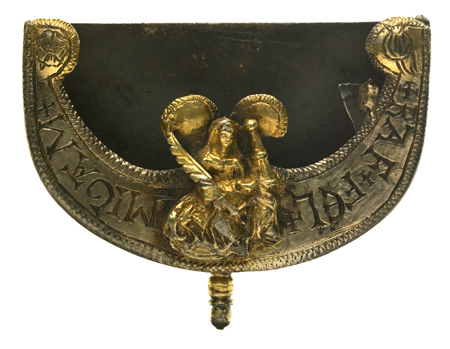
Tudor belt chape
This silver-gilt chape (protective cap for a belt-end) bears a cast-relief figure of St Barbara.
However, perhaps the finest depiction of St Barbara in the Museum of London collections is on a small belt-chape or belt-end (a protective metal covering for the end of a leather belt). It is on display in the Medieval London Gallery as it also depicts the symbols of Henry VIII and Katherine of Aragon, a rose and a pomegranate. The Barbara figure on it is minute but holds a palm and tower and is worked in wonderful detail in silver gilt. This object is of a higher status than the other Barbara items in the collection and belonged to Ralph Felmingham, a Sergeant-at-arms to Henry VIII.
So what of St Barbara today? In 1969, due to the uncertainty surrounding the details of her life she was removed from the Catholic Church’s General Roman Calendar, although she remains on the Catholic Church’s list of saints. In certain parts of the world she is still extremely popular as a saint, particularly in Poland, Germany and Austria, where her saint’s day, 4th December, is still celebrated, particularly among communities with a strong mining tradition. She also remains an important saint for the Eastern Orthodox Church and her saint’s day is celebrated in many places in Greece, Lebanon and elsewhere in the eastern Mediterranean.
Relics of St Barbara can be found chiefly in Kiev, but also in Venice and the United States. Those in Kiev were brought there from Constantinople in the 12th century. The Spanish and Portuguese brought her veneration with them to the Americas in the 16th and 17th centuries, most notably with the naming of Santa Barbara in California, and she has been integrated into Afro-Cuban and Afro-Brazilian religions, again associated with storms and fire.
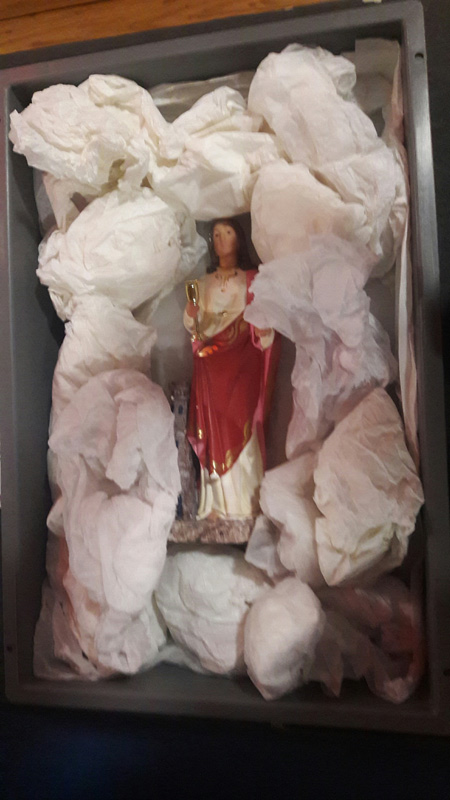
Today she is still recognised as the patron saint of
artillery men, military engineers, armourers, fire-fighters, miners and
tunnellers, as well as mathematicians and geologists, amongst others. She is
the Patron Saint of the Italian Navy, the Artillery Corps of the Irish Army,
The Royal Regiment of Canadian Artillery, as well as many others. The Unites
States Army Field Artillery Association award the Honourable Order of St
Barbara and armed forces throughout the world celebrate her saint’s day.
When we were planning the 2017 Tunnel exhibition, we were told about the St Barbara tradition amongst the miners and tunnellers who worked on the project. We asked if it would be possible to borrow one of the statues of the saint that had been placed in the tunnels whilst construction work was going on and were delighted when the company Dragados UK and Ireland, who constructed the Crossrail Eastern Running Tunnels, kindly decided to donate the statue to the Museum. This small statue (just under 32 cm in height) is made of plaster and is slightly chipped from her four years, from 2012 to 2016, in the main shaft at the Limmo Peninsula site in east London. She still holds a plastic chalice in one hand but the sword that was in her other hand is now missing. Each day as the tunnellers and miners went to work they passed her. At the exhibition, she was the first object that visitors would walk past when they entered the display.
The Tunnel: the Archaeology of Crossrail exhibition closed in September 2017.








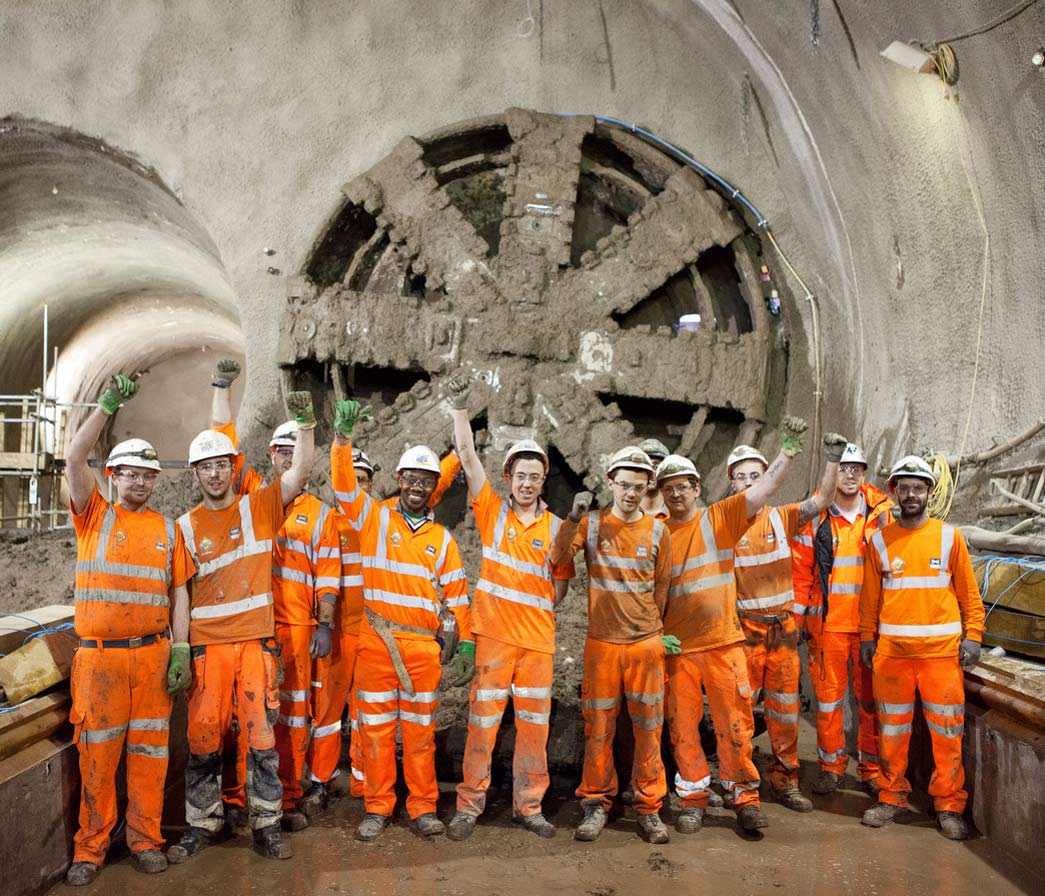
![In the mid-15th century an exceptional work of art appeared in Silesia – the Altarpiece of Saint Barbara. This altarpiece adorned the main altar of St Barbara’s Church in Wrocław [Vrotz-wahv].](/application/files/2914/9157/5191/Wilhelm_Kalteysen_-_Saint_Barbara_Altarpiece_-_Google_Art_Project.jpg)
